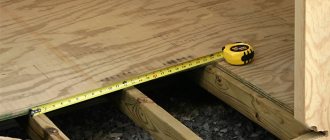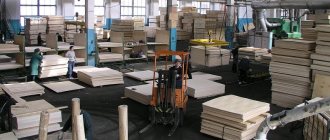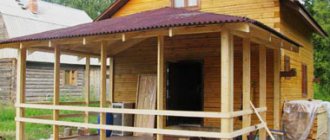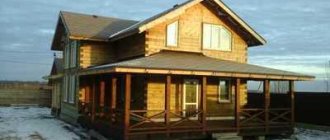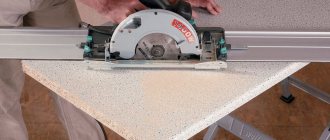How to permanently repair a crack in a timber or log.
Cracks inside wood can occur for various reasons. Sometimes they appear due to excess stress inside the wood, seasonal shrinkage, mechanical damage or other reasons. In order to eliminate them, you will need to use a wide arsenal of products - sealants, putties, adhesives and other products that are aimed at different types of defects. This article will discuss the best technologies and materials that are used to repair cracks in logs and beams - we are talking about large longitudinal cracks and small chips.
Wood putty
Wood putties are paste-like compounds that are used to cover cracks, fill depressions and level the surface. Yes, puttying has become the most popular method for eliminating defects in wood due to the availability and simplicity of the method. This technique has a number of undeniable advantages, but also requires knowledge of some nuances. Due to the fact that the composition is viscous, it is possible to perfectly fill cracks and depressions. After drying, which occurs quite quickly, the material gains strength, and then it can be used to subject it to standard wood processing procedures - sanding, planing and sawing.
All coatings that form a film - paint, enamel and varnish - will fit perfectly onto the frozen layer of putty. Due to the various tinting options, you can easily select a putty to match the wood that you plan to restore - this is extremely important if you plan to apply varnish, wax or stain in the future.
Wood putty can be divided into two main groups:
putties made from an alkyd, water-based or other binder, and they are usually produced in ready-made form. Such materials are affordable and quite practical - you just need to mix the mixture with the consistency of a paste, and then you can start all the work. The relatively long life of the mixture allows you to slowly work with large volumes of space, namely, sealing cracks in a wooden floor or leveling other large-scale surfaces.
One-component –- Two-component - compositions that are offered for purchase in the form of two different components - a hardener and a putty. They should be mixed immediately before work begins, and all recommendations specified by the manufacturer should be strictly followed. This differs from the first version of the composition in that it is more durable, has greater elasticity, and there is practically no shrinkage, and it is also resistant to water and solvents.
For the most part, the disadvantages are relative - high cost and rapid hardening. The lifetime of a two-component putty is approximately 5 minutes, which creates some inconvenience when working with a large area, so such products are often used only for local repairs - to cover up a crack in a small area.
How to cover up a crack
The basic principles of working with putty are shown using the example of how to seal a large meticulous crack in a walnut cut. The example photo shows what the restored board looks like after applying the wax finish. The composition for sealing cracks in timber should be applied with a spatula, while tightly filling the crack cavity. All putties gain strength after drying, but their hardness will not be compensated by sufficiently high elasticity. With large fluctuations in the size of wood, which are caused by its shrinkage and swelling, the joints that are puttied begin to crack over time. For this reason, this sealing method is effective for the most part only for interior work, where differences in humidity and temperature are not as great as outside.
Methods for protecting timber and logs from cracking
Protecting lumber from cracks should begin in the forest, when the tree is cut down to make it. The above-mentioned process of feeding trees with useful substances dissolved in groundwater was described for a reason. Understanding this process makes it possible, even at the stage of felling, to significantly reduce the cracking of logs and beams in log houses. And this method is dictated by nature itself. Everyone knows that a tree does not feed and grow all year round. In winter it “sleeps”. Accordingly, it does not absorb moisture from the soil. If it is cut down precisely during this period of the year, then the natural moisture content of the lumber obtained from it will be minimal. Less moisture will evaporate. Accordingly, there will also be fewer cracks. Next comes the stage of manufacturing timber and logs. To protect the material from cracking, artificial cracks are made in it - longitudinal cuts that partially relieve internal stresses. After assembling the log house, such cuts remain invisible, as they are made in the places where the crowns join. As a result, even if a beam or log cracks, it will be in the weakest place, which will be these same cuts made in advance. Such cracks will no longer spoil the appearance of the building and will not cause the formation of cold bridges.
The next method of protecting wood from cracking is implemented after assembling the frame. This is painting . By covering a log or timber with some kind of film-forming composition, we block the escape routes for moisture, and also protect the material from external moisture and attack by microorganisms.
A mixture of glue and wood shavings
Also, in addition to the material for sealing cracks, you can also use a mixture made from wood glue and small wood shavings. This method is not suitable for correcting wide depressions and leveling large surfaces, but it is more reliable as an alternative to putties during local repair of cracks. Unlike putty compounds, which, despite their merits, only fill cracks, a filler made from shavings and glue will help further ensure bonding strength.
In those places where the putty composition will sooner or later begin to crack due to various factors such as seasonal fluctuations, a self-made glue filler will be able to withstand the test of time. It is recommended for use for sealing cracks along carpentry joints, repairing cracks in wood doors and other places where the seam is subject to stress.
Ideally, the adhesive should be mixed with fine wood dust that is generated during sanding. When drying, this composition will shrink significantly. Therefore, when filling cracks, it should be applied in large quantities, so that it protrudes above the surface. After everything is dry, you can carefully remove the excess using a sharp chisel, and the area that has been repaired should be sanded with fine-grained sandpaper.
Please note that you should think about cracks during design. Due to seasonal fluctuations in humidity levels, wood constantly changes dimensions, and this important feature, as well as all the others, should not be forgotten during the design and creation of most carpentry projects. In particular, during the manufacture of tables from laminated board and solid wood, since the lid needs to be attached using special fittings, which will allow the wood to easily change sizes. Rigid installation of the tabletop, which will be tightly screwed to the frames, will lead to the fact that it will begin to warp and long longitudinal cracks will form.
Why are cracks in logs dangerous?
Microcracks do not pose a serious threat to the integrity of the building. Deep (3–5 mm deep) longitudinal cracks and breaks can lead to uneven shrinkage and deformation of the log house. This, in turn, can lead to the complete disrepair of the building.
Minor cracks and grooves should not be ignored. Over time, moisture accumulates in them, contributing to the formation of fungus and mold. Invaded bark beetles can also cause the destruction of the strongest frame and lead to a decrease in heat and waterproofing properties.
Timely repair of cracks can prevent further deformation of the log. If deep cracks and longitudinal splits do appear in the log, they must be eliminated immediately.
Epoxy resin
Using epoxy resin is perhaps the most reliable method for repairing cracks. Two-component type products, which consist of a hardener and resin, can be easily modified into an adhesive filler. With their help, you can obtain a composition of the shade and viscosity you require, which can perfectly fill all cracks, chips, potholes and help create a strong bond.
After hardening, the epoxy resin will begin to gain strength, which exceeds the strength of wood, and due to its fluidity and excellent adhesion, it will penetrate into all cavities and thus restore the original integral structure of the wooden product, and will also prevent the further spread of cracks. This method is often used when working with solid wood, when the problem of cracks worsens due to high internal stress.
After the epoxy resin has completely hardened, it will turn into an inert and completely safe plastic that will have increased strength. The resin can be used to repair defects in products that come into contact with food, such as repairing kitchen countertops or repairing cracks in a cutting board or dining table. Epoxy resin makes it possible not only to fill a crack in a beam/log/wood product and thereby hide cosmetic defects, but also to completely stabilize the condition of the wood. Often this is only the only opportunity to bring back to life a timber that seems to be completely and completely damaged by through cracks, as shown in the photo below.
Butterfly dowels for crack stabilization
Large cracks can become not just a headache, but even a natural decoration of the overall design of the project. To a greater extent, this will apply to products made from slabs - these are massive cuts of wood, which are subsequently used to make table covers, seats for benches and other elements. In such furniture, wide cracks can preserve the philosophy of the Live ege style, which is characterized by interference with the natural forms of wood. But in order for a crack not to be a defect and become a real decoration, it first needs to be stabilized. If this is not done, it will continue to expand and after some time will split the wood part into two halves.
To perform stabilization, functional and decorative elements such as butterfly dowels are usually used. They should be glued into grooves that were milled in advance. The standard thickness of the dowel will be 1-1.5 cm. The number and size of the embedded butterflies is an entirely individual matter, since it will depend on the size of the part and the nature of the crack. To enhance the decorative effect, stabilizing inserts are made from wood species that have contrasting colors.
Wax correctors
Special sticks made from hard wax are a simple and extremely convenient solution for cosmetic repairs of small cracks, dents, chips, deep scratches and other defects. Wax correctors have become very popular as a means of redecorating furniture and other wooden products that are used indoors and are not subject to much wear and tear. Wax concealers are usually offered in colors that imitate different types of wood. The colors can be easily mixed to obtain the desired shade.
Before starting work, the area to be repaired should be prepared - clean it of dust and various contaminants, remove chipped nicks. Wax correctors should be used at a temperature that is not lower than +10 degrees. First, polish the restoration site gently with a lint-free cloth. Next, you should apply the wax with force to the damaged areas so that it is thoroughly packed into all cavities.
Methods for eliminating cracks in logs
The technology for sealing cracks depends on their size. Thus, small (up to 2–3 mm) longitudinal cracks are sealed with sealant, dry mixtures, and hardening putties. Cracks and splits larger than 5 mm are filled with a special insulating material and then sealed.
Important! When starting to seal cracks, you must first clean them of debris and rot and completely remove loose wood.
Grouting microcracks with sandpaper
Microcracks that have just begun to appear on the log should also not be ignored. If they are not eliminated at the initial stage, the cracks will grow deeper into the wood.
You need to sand the cracks manually, selecting the grain of the paper to match the wood. Thus, soft wood is treated with fine-grained paper, while harder varieties are treated with coarse grain. Wood dust generated during processing also serves as a primer. After sanding, the surface is impregnated with antiseptic and varnish.
Grout from sawdust and wood glue or PVA
Small cracks can be easily eliminated with a homemade grout made from fine sawdust and glue (wood glue or PVA) in a 5:1 ratio and mixed thoroughly. The mixture should be thick enough, but not dry, to evenly fill the voids in the wood.
Repairing the crack
Using a spatula, the grout should be pushed into the cracks and compacted if possible. As the mixture dries, it decreases in volume, so it may be necessary to re-grout with the mixture or wood putty.
Wood putty
Acrylic putties are suitable for filling small cracks - no more than 3 mm. With deeper layers, the dried material will begin to crack and fall out.
Ready-made wood putties are highly waterproof and frost-resistant. In addition, you can choose a mixture that matches the color of a particular type of wood.
Acrylic, polyurethane sealants
The use of acrylic or polyurethane sealant is advisable only to a depth of 5 mm. If the crack in the log is deep, its space is filled with a sealant made of foamed polyethylene, and only after that the surface is filled with sealant using a syringe. At the same time, polyethylene does not react with glue, remaining a kind of shock-absorbing cushion inside the wood.
Arbogypsum
An excellent product for sealing cracks in logs is an arbogypsum mixture. In addition to gypsum, it contains filler made from natural raw materials. Usually this is crushed tree bark, tyrsa, sawdust or straw.
Arbogypsum in a log crack
Preparation of arbogypsum involves diluting the dry mixture with water, and the ratio of the components should be as follows: 2 parts gypsum, 6 parts crushed wood, 1 part water. To give the mass plasticity, you can add 1-2 drops of thick shampoo. The resulting mixture is thoroughly mixed until smooth and used immediately.
The prepared arbogypsum solution is placed into the cracks using a spatula, compacted, smoothed over the surface and left to dry completely.
The method of plastering cracks is considered the most durable and durable. This is due to the strong adhesion of both components.
Filling cracks with wood chips
Large, deep cracks are clogged with wedges made from wood chips. The size of the wedge must exceed the size of the slot. To ensure a tight fit, it is hammered in with a hammer, having previously been coated with PVA glue for complete setting.
Next, the surface is puttied with wood putty or a homemade mixture of PVA and sawdust.
Filling cracks and cracks with moss, tow, jute (caulking)
Caulking with moss is a traditional, reliable method of sealing cracks and crevices in log houses. This natural material is an excellent heat-insulating filler, suitable for sealing the deepest cracks.
For caulking, take dry moss, pre-soaked in water for half an hour. After squeezing it well, the moss is rolled out with rollers and driven tightly into the cracks and cracks using a mallet and a wooden spatula.
Sealing cracks in a log house with moss
After drying, the moss increases in volume, densely penetrating into all microcracks. After 2–3 days, you can smooth out the protruding moss residues with a sanding machine.
The use of tow and jute to seal cracks follows the same pattern as with moss, but without soaking.
Causes of cracking
- High humidity of round timber.
Wooden log houses are built from wood with a moisture content of 20-22%. If the humidity is higher, then cracks on the facade appear after 3-4 weeks. The process is due to the fact that the top layer dries faster than the middle. This causes internal stresses within the material.
- Incorrect design.
When designing, it is necessary to calculate and compensate for all loads on the frame. To reduce the pressure on the log structure from the heavy roof, they plan to install racks.
- Unprofessional installation.
If the construction technology is not followed, cracks appear at the joints of the logs. With careful adjustment of the crowns and organization of compensation gaps in the openings, the number of cold “bridges” is minimal.
- Failure to follow the rules for caring for the log house during shrinkage.
It is not recommended to turn on the heating for 1.5-2 years. It is necessary to control the vertical and horizontal deviation of the structure and adjust the shrinkage compensators.
Physical causes of cracks
As the round wood dries, it decreases in size. When completely dry, the pine will shrink along the grain by 0.1 - 0.3%, and across it - from 3 to 5%. The shrinkage of the inner and outer layers is different: in pine, the inner layers are reduced by 2.91%, and the outer layers by 8.22%. The difference is due to the different densities of the wood: in pine, the density becomes greater away from the bark in the core. The layers located in the region of ⅔ of the trunk radius have the maximum density.
When drying, the layers on the surface tend to decrease in size, while the inside still remains moist. As a result, the dry zone is subject to tensile stresses, while the inner zone is subjected to compressive forces. The magnitude of the tension can exceed the tensile strength of wood across the grain. In this case, the surface layers are torn and a crack appears. When wood dries naturally, the outer layers always dry out faster, so cracking cannot be avoided.
What to do with already formed cracks?
Even if you apply all the above methods to protect wood from cracking, cracks will still occur. Sooner or later. Big or small. But they will be guaranteed. To prevent them from turning into cold bridges and homes for microorganisms and insects, they must be eliminated in a timely manner.
This is done in different ways. One of the simplest is to use colorless sealant . Cracks can also be caulked or sealed with putty. The ends of a log or beam require special attention. It is recommended to paint them or treat them with some modern compounds that are designed specifically for these purposes.
After sealing the cracks, repainting occurs. This will have to be done throughout almost the entire life of the wooden housing. This is the only way it will last as long as possible - it will be warm and comfortable, will not lose its presentability, will not rot and will not be eaten by wood-boring insects.
